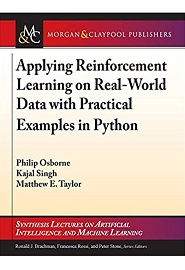
English | 2022 | ISBN: 978-1636393445 | 110 Pages | PDF | 10 MB
Applying Reinforcement Learning on Real-World Data with Practical Examples in Python (Synthesis Lectures on Artificial Intelligence and Machine Learning)
Reinforcement learning is a powerful tool in artificial intelligence in which virtual or physical agents learn to optimize their decision making to achieve long-term goals. In some cases, this machine learning approach can save programmers time, outperform existing controllers, reach super-human performance, and continually adapt to changing conditions. It has shown human level performance on a number of tasks (REF) and the methodology for automation in robotics and self-driving cars (REF). This book argues that these successes show reinforcement learning can be adopted successfully in many different situations, including robot control, stock trading, supply chain optimization, and plant control.
However, reinforcement learning has traditionally been limited to applications in virtual environments or simulations in which the setup is already provided. Furthermore, experimentation may be completed for an almost limitless number of attempts risk-free. In many real-life tasks, applying reinforcement learning is not as simple as (1) data is not in the correct form for reinforcement learning; (2) data is scarce, and (3) automation has limitations in the real-world.
Therefore, this book is written to help academics, domain specialists, and data enthusiast alike to understand the basic principles of applying reinforcement learning to real-world problems. This is achieved by focusing on the process of taking practical examples and modeling standard data into the correct form required to then apply basic agents. To further assist readers gain a deep and grounded understanding of the approaches, the book shows hand-calculated examples in full and then how this can be achieved in a more automated manner with code.
For decision makers who are interested in reinforcement learning as a solution but are not proficient, the book includes simple, non-technical examples in the introduction and case studies section. These provide context of what reinforcement learning offer but also the challenges and risks associated with applying it in practice. Specifically, these sections illustrate the differences between reinforcement learning and other machine learning approaches as well as how well-known companies have found success using the approach to their problems.
HomepageResolve the captcha to access the links!